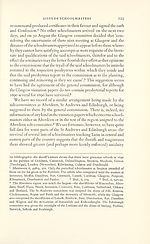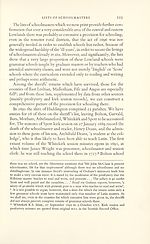Series 4 > Miscellany of the Scottish History Society
(149) Page 124
Download files
Complete book:
Individual page:
Thumbnail gallery: Grid view | List view

124
MISCELLANY X
in meeting the commission’s requirements than did their counter¬
parts elsewhere. These lists will be found printed below as documents
3 to 9.
The information which is thus made available allows us to gain a
better appreciation than has been possible hitherto of the number and
type of schools provided in a large area of the Lowlands in the period
immediately preceding the 1696 Act for Settling of Schools. The
passing of this act has long been assumed to indicate that Scotland was
at that time grossly deficient in schooling and that the prior acts in
favour of the establishment of parochial schools in 1616, 1633 and
1646 had been ineffective. Beale, in the course of his meticulous re¬
searches among the seventeenth-century records for Fife, concluded
that this traditional view was wholly inappropriate in reference to
that county. Far from judging the post-Restoration period as a time
of inactivity or decline in educational affairs—this has been very
widely presumed by preshyterian apologists of the last and of this
century—Beale maintains that the years 1660-96 provided in Fife
‘a story of growth and change, of a system developing in an era of
civil and religious strife’.1 A recent study of the educational provision
in another Lowland county, East Lothian, supplements and supports
his judgment in this matter.2
1 J. M. Beale, A History of the Burgh and Parochial Schools of Fife from the Reforma¬
tion to 1872, p. 156 (unpublished ph.d. thesis, University of Edinburgh, 1953).
2 ‘Schools in the Presbytery of Haddington in the seventeenth century’ in Transactions
of the East Lothian Antiquarian and Field Naturalists’ Society, ix (1963), 90-111. Boyd,
op. cit., is among the latest of a long succession of writers to conclude that between
the Restoration and the 1696 Act-the school system ‘came near to complete wreckage’
(p. 39). But Boyd’s treatment of his sources is on occasion very unsatisfactory. He
refers, for example, to the report to the Glasgow sub-committee in 1696 by the presby¬
tery of Irvine to show the ‘dismal picture’ of education there just before the passing
of the Act for Settling of Schools, but does not go to the original printed in the
Munimenta. Instead he is content to restate the misleading summary supplied by Henry
Grey Graham in his Social Life in Scotland in the eighteenth century (2nd edn., 1901,
p. 42m.). In the parish of Kilmaurs in 1696 Graham and Boyd maintain that there was
‘no salary, or house, or school’; but the original account of the parish reads: ‘For
Kilmaurs the present schoolmaster is Mr Alexander McCalpin, very fitt for that office
and supposed qualified according to law, but no sailary allowed from the parish, nor
house to dwell in, not yet a convenient schoolhouse’ (Munimenta, ii, 547). The modera¬
tor of the presbytery was at pains to declare that there were no schoolmasters or only
‘poor men’ teaching at present or, in the interim between the departure of one and the
arrival of another qualified master, in Dunlop, Kilbride, Ardrossan and Beith. Neither
Graham nor Boyd acknowledges this emphasis in reporting that those parishes had
no schools or were insufficiently supplied. Further, the latter both state that in Largs
MISCELLANY X
in meeting the commission’s requirements than did their counter¬
parts elsewhere. These lists will be found printed below as documents
3 to 9.
The information which is thus made available allows us to gain a
better appreciation than has been possible hitherto of the number and
type of schools provided in a large area of the Lowlands in the period
immediately preceding the 1696 Act for Settling of Schools. The
passing of this act has long been assumed to indicate that Scotland was
at that time grossly deficient in schooling and that the prior acts in
favour of the establishment of parochial schools in 1616, 1633 and
1646 had been ineffective. Beale, in the course of his meticulous re¬
searches among the seventeenth-century records for Fife, concluded
that this traditional view was wholly inappropriate in reference to
that county. Far from judging the post-Restoration period as a time
of inactivity or decline in educational affairs—this has been very
widely presumed by preshyterian apologists of the last and of this
century—Beale maintains that the years 1660-96 provided in Fife
‘a story of growth and change, of a system developing in an era of
civil and religious strife’.1 A recent study of the educational provision
in another Lowland county, East Lothian, supplements and supports
his judgment in this matter.2
1 J. M. Beale, A History of the Burgh and Parochial Schools of Fife from the Reforma¬
tion to 1872, p. 156 (unpublished ph.d. thesis, University of Edinburgh, 1953).
2 ‘Schools in the Presbytery of Haddington in the seventeenth century’ in Transactions
of the East Lothian Antiquarian and Field Naturalists’ Society, ix (1963), 90-111. Boyd,
op. cit., is among the latest of a long succession of writers to conclude that between
the Restoration and the 1696 Act-the school system ‘came near to complete wreckage’
(p. 39). But Boyd’s treatment of his sources is on occasion very unsatisfactory. He
refers, for example, to the report to the Glasgow sub-committee in 1696 by the presby¬
tery of Irvine to show the ‘dismal picture’ of education there just before the passing
of the Act for Settling of Schools, but does not go to the original printed in the
Munimenta. Instead he is content to restate the misleading summary supplied by Henry
Grey Graham in his Social Life in Scotland in the eighteenth century (2nd edn., 1901,
p. 42m.). In the parish of Kilmaurs in 1696 Graham and Boyd maintain that there was
‘no salary, or house, or school’; but the original account of the parish reads: ‘For
Kilmaurs the present schoolmaster is Mr Alexander McCalpin, very fitt for that office
and supposed qualified according to law, but no sailary allowed from the parish, nor
house to dwell in, not yet a convenient schoolhouse’ (Munimenta, ii, 547). The modera¬
tor of the presbytery was at pains to declare that there were no schoolmasters or only
‘poor men’ teaching at present or, in the interim between the departure of one and the
arrival of another qualified master, in Dunlop, Kilbride, Ardrossan and Beith. Neither
Graham nor Boyd acknowledges this emphasis in reporting that those parishes had
no schools or were insufficiently supplied. Further, the latter both state that in Largs
Set display mode to:
![]() Universal Viewer |
Universal Viewer | ![]() Mirador |
Large image | Transcription
Mirador |
Large image | Transcription
Images and transcriptions on this page, including medium image downloads, may be used under the Creative Commons Attribution 4.0 International Licence unless otherwise stated. ![]()
| Scottish History Society volumes > Series 4 > Miscellany of the Scottish History Society > (149) Page 124 |
|---|
| Permanent URL | https://digital.nls.uk/126694671 |
|---|
| Description | Over 180 volumes, published by the Scottish History Society, containing original sources on Scotland's history and people. With a wide range of subjects, the books collectively cover all periods from the 12th to 20th centuries, and reflect changing trends in Scottish history. Sources are accompanied by scholarly interpretation, references and bibliographies. Volumes are usually published annually, and more digitised volumes will be added as they become available. |
|---|


